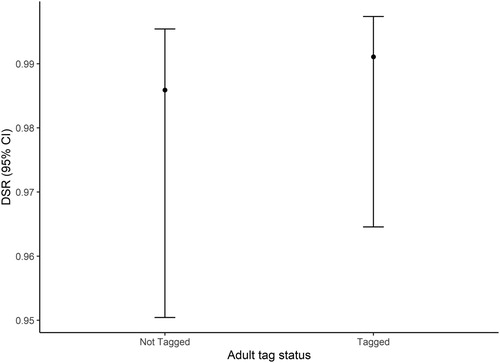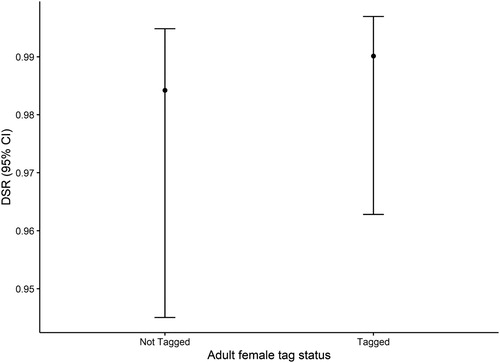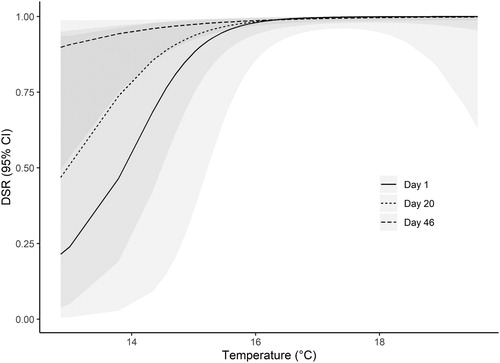Figures & data
Table 1. Summary of outcomes for monitored Nightjar nests. Total number of successful nests (fledging one chick or more) and percentage success rates, with a breakdown by tag status of the attending adults and brood number.
Table 2. Summary of number of Nightjar nests attended by tagged parents, broken down by brood status.
Table 3. Conditional model averaged estimates (± se) of the effects of mean rainfall, mean temperature, nest age, time (days from 28th of May), construction year, adult female tag status, and adult male or female tag status, on daily nest survival rates (DSR) of Nightjars at Brechfa Forest. Model averaged parameter estimates were derived by weighted averaging across all models within 2 AICc units of the top model (). Parameters in bold are considered to have an important effect based on 95% CL.
Table 4. Full model averaged estimates (± se) of the effects of mean rainfall, mean temperature, nest age, time (days from 28th of May), construction year, adult female tag status, and adult male or female tag status, on daily nest survival rates (DSR) of Nightjars at Brechfa Forest. Model averaged parameter estimates were derived by weighted averaging across all models within 2 AICc units of the top model (). Parameters in bold are considered to have an important effect based on 95% CL.
Figure 1. Relationship between daily survival rate (DSR) and radio tag deployment status of parental adult Nightjar at Brechfa Forest, Carmarthenshire, Wales, 2013–2019. Daily survival results are based on 85 nests pooled across 2013–2019. The points represent the estimated mean DSR values, and the bars represent the 95% confidence intervals.

Figure 2. Relationship between daily survival rate (DSR) and radio tag deployment status of parental female adult Nightjar at Brechfa Forest, Carmarthenshire, Wales, 2013–2019. Daily survival results are based on 85 nests pooled across 2013–2019. The points represent the estimated mean DSR values, and the bars represent the 95% confidence intervals.

Table 5. Top models (models within 2 AICc units of the top model) of Nightjar daily nest survival rates, for a set of models including mean rainfall (m_prcp2), average temperature (m_temp), nest age (NestAge), time (Julian day), adult female tag status (f_tag), year (2013–2019), and adult tag status (fm_tag).
Figure 3. Model averaged predicted daily nest survival rate in relation to mean temperature during the Nightjar nesting period in Brechfa Forest, Carmarthenshire, Wales, 2013-2019. Estimates (lines) and 95% confidence bands (shaded) are shown for day 1 of the season (28th May), day 20 (16th June–median nest initiation date), and day 46 (12th July – median hatch date), with other covariates fixed at mean values.

